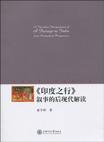《印度之行》叙事的后现代解读
出版时间:2010-4 出版社:上海交通大学出版社 作者:索宇环 页数:173
前言
叙事学发展到后现代,已不仅仅是关于文学叙事作品里诸如叙述者、叙述视角、人物、情节等叙事手段的工作原理的学科,而是扩大为包括小说、神话、日记、游记、谈话、电影、广告、戏剧、档案、诉状等一切语篇中诸如叙述者、叙述视角、作者、读者、人物、情节、声音、时间、空间等叙事手段与政治、经济、文化、法律、道德、伦理、阶级、种族、性别等社会要素之间的互动关系。叙事学发展到这个阶段和层次,已经不再是一个单一的学科了,而是跨越了很多相关领域的庞大而复杂的科学体系。后现代是一个更加理性、更加人性的时代。叙事不仅是语言的、诗学的、美学的工程,而且也是政治的、经济的、伦理的、道德的体现。叙事不仅是作者的、叙述者的创造,而且也是读者的、批评者的成果。后现代叙事理论强化了叙事行为和叙事作品中的人的要素,作者的声音、叙述者的意志、人物的立场、读者的经历、批评者的视角共同参与到叙事作品的建构和解构过程中来,使得叙事作品生动、丰富、曲折、耐人寻味,而且也使得叙事作品具有了永无止境的解读空间。 英国小说家爱德华·摩根·福斯特发表于1924年的《印度之行》,不仅为作者带来了无与伦比的荣誉,而且也给世界留下了一个魅力永恒的谜题。这部小说的魅力到底体现在哪里?小说中的景物描写那般荒凉沉闷,故事里的人物既非绝代佳人,又非盖世英雄,情节朴素简单,既无杀戮,亦无艳遇,究竟是什么让几代读者对它爱不释手,潜心钻研? 经过本人多年的阅读和思考,对此问题有了一个临时的答案,那就是作者福斯特在这部小说里做了一个超越时空的跨越,而且是多维度的跨越,所以才对读者构成了意识形态、政治、美学、种族、阶级、性别、诗学领悟力和承受力的多方挑战。摩尔夫人与阿德拉的印度之行,不仅是一次远涉重洋的跨洲旅行,更是一次民族跨越,是盎格鲁人与印度人这两个文化渊源迥异的民族进行的一次大胆的亲密接触;摩尔夫人、阿德拉、菲尔丁与阿齐兹之间的友谊是两个阶级(中产阶级与劳动阶级)、两个宗教(基督教与伊斯兰教)的跨越;英国殖民统治印度不可避免地会发生东西两大文明碰撞。这些超乎常人的跨越本身就足以令读者瞠目结舌了,不仅如此,福斯特还向我们推出了性别跨越(女性变被动为主动,闯进男性的领地,主动出击,探索性爱的极限,挑战婚姻的权威)和政治跨越(殖民者和被殖民者这两个地位和利益截然冲突的社会阶层进行深层次的接触和交流,俨然一个乌托邦式的殖民模式)。
内容概要
《叙事的后现代解读》运用后现代叙事学中的政治、文化、宗教、伦理等视角,对20世纪英国著名作家E.M.福斯特的代表作《印度之行》进行叙述视角、叙述结构、情节、空间等方面的细致的文本分析解读。《叙事的后现代解读》以一部专著解读一部小说的方式,在国内叙事学研究领域中较为少见,因而成为同类作品中的显著者。《叙事的后现代解读》适合高等院校人文、外语学科的教师和学生阅读。
书籍目录
Introduction Chapter 1 Established Criticisms and Remaining Questions 1.1 Established Criticisms on Forster's A Passage to India 1.1.1 Criticism in the West 1.1.2 Criticism in China 1.2 Remaining Questions about A Passage to India Chapter 2 Postmodern Narrative Theory 2.1 Reading as Discovery 2.2 Interpretation as Multiplicity 2.3 Narrative as a Socially Symbolic Act Chapter 3 Point of View and Politics 3.1 Multiple Points of View and Racial Politics 3.2 Variable Point of View and Gender Politics 3.3 External Point of View and Universalism 3.4 Internal Point of View and Liberal Humanism Chapter 4 Space and Culture 4.1 The Mosque and Home of the Soul 4.2 The Civil Station and English Metropolitan Life 4.3 The Tennis Lawns and Racial Gap 4.4 The Maidan and Fellowship 4.5 Mr.Fielding's Living-Room and Anglo-Indian Utopia 4.6 Aziz's Bedroom and Brotherhood 4.7 The Caves and the Primitive Power 4.8 The Court and Nationalism 4.9 The Temple and the Secular God Chapter 5 Narrative Structure and Religious Orientation 5.1 Fomininity——Masculinity——Birth 5.2 Union——Dissolution——Union 5.3 Society——Solitude——Society Chapter 6 Plot and Ethics 6.1 Loyalty 6.2 Responsibility 6.3 Love, Sex, and Marriage Conclusion Bibliography Acknowledgements
章节摘录
Question 8:What accounts for the break in Forster'swriting APassage to India? E.M.Forster started writing his novel A Passage to India in 1913 soon after his return from the first visit to India,but in June 1914 he abandoned the manuscript for unknown reasons.It was in 1922 when he returned from his second visit to India that he resumed his writing in earnest and completed it in 1924.The progress of Forster's writing the novel made a dramatic scene in England.The public first expected with excitement,but then they began to express worry,or even disappointment.The novel came out just in time to save the public from despair.The novel did not disappoint the anxious readers.It was a big and immediate Success.When the readers were drowned in the pleasure of reading,no one cared about the mysterious break in the writinQ progress·But,is it not a significant question?What happened to him in 1914 that stopped him from writing?Why did he pick up the writing after laying it aside for solong?Did the break produce any influence on the resumed work?Is there any discernible gap between the earlier part(or version)and the later part(or version)7 These questions will not merely amount to a historical documentation but moreimportant to some new insights into the novel as an artistic work. Question 9:IsAPassage to India a modernist novel? I his question may at the first encounter sound silly because Forster lived and wrote in the high time of Modernism and enjoyed a close and firm relationshiD withthe core of the Bloomsbury Group.But A Passage to India created manV puzzIes forthe modernist readers.They found no anti-traditional discourse and images;instead they perceived a strong anti-British sentiment.They saw no stream-of-consciousnesselement in the novel;instead,they identified many mystical and religious elements.Is A Passage to India a modernist novel?If yes,what distinction does it reDresent incomparison with other great works of the modernist genre?If not,what category doesit fall in?As a widely-read and intensely controversial novel,how much does ittranscend its historical limit?How much inspiration can a postmodernist reader drawfrom it?Does it embrace and indulge a multitude of interpretations as Islam andHinduism do about the diversity of Indian religions?Does A Passage to Indiaexemplify the principles in Aspects of the Novel,or is the latter an abstraction of theformer?
图书封面
评论、评分、阅读与下载
用户评论 (总计0条)
推荐图书
- 中国国家标准汇编
- 中国国家标准汇编 2008年修订-100
- 中国国家标准汇编 2008年修订-72
- 中国国家标准汇编
- 絵描きのためのチームBLポーズ写真集
- 中国語圏における厨川白村現象
- 阀门制造工艺入门与精通
- 建筑工程施工图审查常见问题详解
- 看图学修汽车ABS
- 中国机械工业60年图鉴
- 大型循环流化床锅炉机组工艺设计
- 水轮发电机组及其辅助设备运行
- 火电厂热工过程先进控制技术
- 市政工程测量放线速学手册
- 实用电工
- 混凝土结构设计原理
- 电工基础及测量
- 生产技能人员岗位学习指导书·试题库
- 电气工程专业英语
- 2010国外电力市场化改革分析报告
- 路基路面工程
- 电力科技论文写作
- 水电站压力管道
- 汽轮机检修
- 变压器油色谱分析与故障诊断
